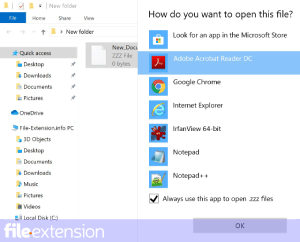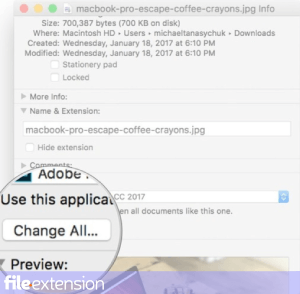
COMMAND File Extension
Terminal Command Format
-
DeveloperApple
-
Category
-
Popularity2.7 (4 votes)
What is COMMAND file?
Full format name of files that use COMMAND extension is Terminal Command Format. Terminal Command Format specification was created by Apple. COMMAND files are supported by software applications available for devices running . COMMAND file format, along with 140 other file formats, belongs to the Executable Files category. The most popular program for handling COMMAND files is Apple Terminal, but users can choose among 3 different programs that support this file format.
Programs which support COMMAND file extension
COMMAND files can be encountered on all system platforms, including mobile, yet there is no guarantee each will properly support such files.
How to open file with COMMAND extension?
Being unable to open files with COMMAND extension can be have various origins. What is important, all common issues related to files with COMMAND extension can be resolved by the users themselves. The process is quick and doesn’t involve an IT expert. The following is a list of guidelines that will help you identify and solve file-related problems.
Step 1. Install Apple Terminal software
 The main and most frequent cause precluding users form opening COMMAND files is that no program that can handle COMMAND files is installed on user’s system. This issue can be addressed by downloading and installing Apple Terminal or different compatible program, such as TextEdit, MacVim, Mac OS X. The full list of programs grouped by operating systems can be found above. One of the most risk-free method of downloading software is using links provided by official distributors. Visit Apple Terminal website and download the installer.
The main and most frequent cause precluding users form opening COMMAND files is that no program that can handle COMMAND files is installed on user’s system. This issue can be addressed by downloading and installing Apple Terminal or different compatible program, such as TextEdit, MacVim, Mac OS X. The full list of programs grouped by operating systems can be found above. One of the most risk-free method of downloading software is using links provided by official distributors. Visit Apple Terminal website and download the installer.
Step 2. Check the version of Apple Terminal and update if needed
 You still cannot access COMMAND files although Apple Terminal is installed on your system? Make sure that the software is up to date. Sometimes software developers introduce new formats in place of that already supports along with newer versions of their applications. The reason that Apple Terminal cannot handle files with COMMAND may be that the software is outdated. The latest version of Apple Terminal should support all file formats that where compatible with older versions of the software.
You still cannot access COMMAND files although Apple Terminal is installed on your system? Make sure that the software is up to date. Sometimes software developers introduce new formats in place of that already supports along with newer versions of their applications. The reason that Apple Terminal cannot handle files with COMMAND may be that the software is outdated. The latest version of Apple Terminal should support all file formats that where compatible with older versions of the software.
Step 3. Assign Apple Terminal to COMMAND files
After installing Apple Terminal (the most recent version) make sure that it is set as the default application to open COMMAND files. The method is quite simple and varies little across operating systems.

Change the default application in Windows
- Choose the entry from the file menu accessed by right-mouse clicking on the COMMAND file
- Click and then select option
- To finalize the process, select entry and using the file explorer select the Apple Terminal installation folder. Confirm by checking Always use this app to open COMMAND files box and clicking button.

Change the default application in Mac OS
- Right-click the COMMAND file and select
- Find the option – click the title if its hidden
- Select the appropriate software and save your settings by clicking
- A message window should appear informing that This change will be applied to all files with COMMAND extension. By clicking you confirm your selection.
Step 4. Check the COMMAND for errors
You closely followed the steps listed in points 1-3, but the problem is still present? You should check whether the file is a proper COMMAND file. Problems with opening the file may arise due to various reasons.

1. Check the COMMAND file for viruses or malware
If the file is infected, the malware that resides in the COMMAND file hinders attempts to open it. Scan the COMMAND file as well as your computer for malware or viruses. If the COMMAND file is indeed infected follow the instructions below.
2. Verify that the COMMAND file’s structure is intact
If you obtained the problematic COMMAND file from a third party, ask them to supply you with another copy. The file might have been copied erroneously and the data lost integrity, which precludes from accessing the file. It could happen the the download process of file with COMMAND extension was interrupted and the file data is defective. Download the file again from the same source.
3. Check if the user that you are logged as has administrative privileges.
There is a possibility that the file in question can only be accessed by users with sufficient system privileges. Switch to an account that has required privileges and try opening the Terminal Command Format file again.
4. Make sure that the system has sufficient resources to run Apple Terminal
The operating systems may note enough free resources to run the application that support COMMAND files. Close all running programs and try opening the COMMAND file.
5. Ensure that you have the latest drivers and system updates and patches installed
Regularly updated system, drivers, and programs keep your computer secure. This may also prevent problems with Terminal Command Format files. It is possible that one of the available system or driver updates may solve the problems with COMMAND files affecting older versions of given software.
Do you want to help?
If you have additional information about the COMMAND file, we will be grateful if you share it with our users. To do this, use the form here and send us your information on COMMAND file.

 MAC OS
MAC OS 



